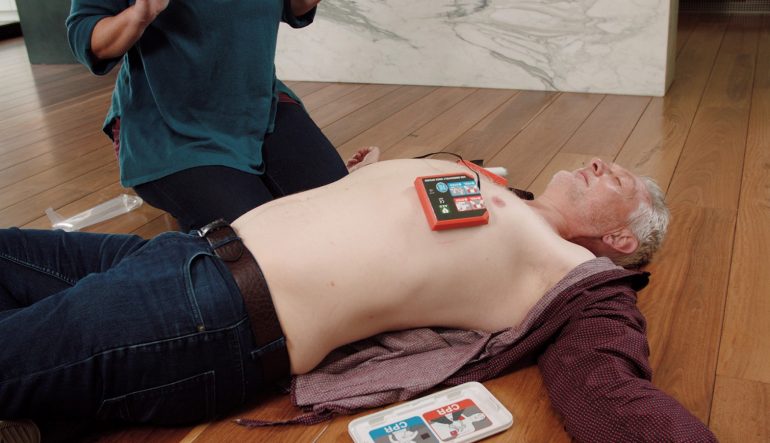CellAED’s RED accreditation
Anyone responsible for managing an AED (automated external defibrillators) network would know this frustration. Even in this IoT-enabled world, why can’t we access AEDs remotely?
Being able to be remotely monitored, maintained and accessed for data would reduce management costs and improve access to critical data when it’s needed. This includes capability of individual devices to automatically share status of critical systems – and during application, upload event data to attending emergency medical services (EMS).
For this to be possible, an AED would need to be able to act like a smart phone, sending and receiving data.
While this functionality is rare in currently-available AEDs, it was built in to the design of CellAED.
In May 2021, CellAED achieved CE Certification, allowing it to be made available in EU member states. As part of this process, CellAED was also required to achieve RED (Radio Equipment Directive) certification from the European Commission.
In this interview, Rapid Response Revival Chief Technical Officer and Chief Information Officer, Scott Casey explains what RED is, and why it is so critical to changing the global paradigm for AEDs.
What is RED?
“The Radio Equipment Directive is the regulations and requirements regarding radio-enabled devices sold in the EU.
“Any electronic device that, for example, uses the internet to connect with a user, uses radio equipment, such as a cellular modem. If you want to legally sell an internet-connected consumer device in the EU, you need RED accreditation.”
Why does CellAED need RED Certification?
“We need RED because CellAED has built-in cellular connectivity and GPS.
“This functionality will allow networks for CellAED devices to be remotely monitored and maintained, without requiring owners to regularly check and maintain the devices themselves.
“It allows a CellAED device to share data from an out-of-hospital cardiac arrest event, and inform attending first responders and clinicians to improve patient outcomes.
“It will help emergency medical services (EMS) and community first responder programs identify and connect nearby CellAED devices and owners to an emergency.
“It will also make it easier for post-event data to be collected by analysts working to improve out-of-hospital cardiac arrest response resources and practices.”
Is RED certification hard to achieve for an AED?
“Any connected device emits energy. When that device connects to the internet, its emissions are high.
“Our device is an AED – which means that its energy emissions spike when it’s applying a shock to a cardiac arrest patient.
“Because they have specific regulations covering AEDs, the assessors of our CE application made allowances for these energy emissions. That application however, also required us to secure RED accreditation – and the RED assessors don’t differentiate between energy emitted during a shock or data communication.
“As a result, it’s a real challenge to design an AED that qualifies for RED accreditation. Solving this challenge was a huge win; we have now created an AED that is approved for remote monitoring and maintenance, that is also allowed to share critical event data with emergency services, to improve patient outcomes.
“To our knowledge, this is a world-first for AEDs. It means CellAED is the only AED in the world that is approved for always-on cellular connectivity.”
“From the outset, we wanted to deliver an AED with this functionality designed in. It took around four years of research and development to reach the point where we were confident it would work.”
Why was achieving this so difficult?
“An AED represents the combination of multiple technologies. These systems can sometimes come into conflict.
“For example, when delivering a shock, an AED can render other capabilities unable to function.
“Currently-available AED manufacturers often get around this problem by housing separate systems in different housings within the unit. As a result, most AEDs are quite large and cumbersome.
“We on the other hand, have created the world’s smallest AED. It has taken a lot of problem-solving by incredibly smart people to develop an AED with balanced, cooperating systems in such a small package.”
Why should we care that CellAED is RED-certified?
“CellAED is going to change the availability, portability and useability of AEDs. It’s also going to change the way AEDs contribute to improving the overall survival rate of sudden cardiac arrest.
“For EMS and volunteer first responder program managers and volunteers, this means being able to monitor, maintain and track AED networks remotely. Given CellAED’s portability, improved tracking also means faster deployment.
“For clinicians, our vision is that this will result in a higher rate of patients having received early defibrillation following an out-of-hospital cardiac arrest. It will also mean faster access to critical event data to aid in treatment.
“For communities and households, it’s about removing the barriers to acquiring and owning an AED, learning how to use one, and preparing to respond in an emergency.
“And for patients, it’s one of the many ways we’re working to increase their chances of surviving a sudden cardiac arrest.”
RELATED ARTICLE: The future of defibrillation isn’t science fiction
DISCLAIMER: CellAED is currently only approved for use in the member states of the EU (European Union). If you would like to be kept informed on when regulatory approval has been secured for your location, register your interest here.



